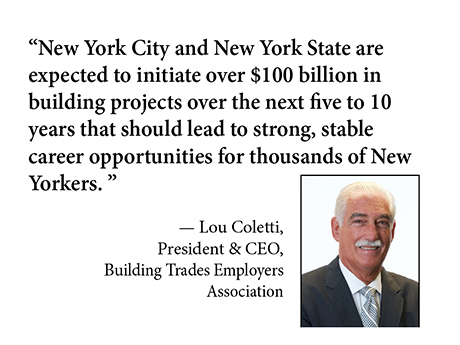By Lou Coletti, president & CEO, Building Trades Employers Association
In the 1930s, the United States was in the throes of the Great Depression. Millions of people lost their jobs, and savings were obliterated overnight. President Franklin Delano Roosevelt seized the opportunity to bring the country back from the brink of economic collapse, creating the Works Progress Administration to put 8.5 million Americans to work building new schools, roads, bridges and water systems.
In 2020, the country faced a similar shock to the system as COVID-19 locked down our cities, shuttered businesses and sent entire populations into isolation for months on end, only to contend with a maze of rules and restrictions as the economy reopened. Almost three years later, major metropolises like New York City have an unprecedented opportunity to rebuild both the physical infrastructure and social fabric of their respective regions.
Much like in the days of the Great Depression, the construction industry has a key role to play in rebuilding our physical and social infrastructure. This time, however, it’s imperative that we prioritize equity, not only within individual projects but also within the industry at large.
The combination of economic upheaval caused by COVID-19 and the influx of funding from the Federal Infrastructure Investment & Jobs Act passed last year, as well as other planned investments by the state and city, has created an opportunity not seen since the 1930s.
New York City and New York State are expected to initiate over $100 billion in building projects over the next five to 10 years that should lead to strong, stable career opportunities for thousands of New Yorkers. Those projects will include the Gateway Rail Tunnel project, the renovation of Penn Station, a new Manhattan Bus Terminal, the expansion of the Second Avenue subway station and many other initiatives.
New York City’s union construction industry was thriving until March 2020, when the pandemic hit and everything bottomed out, halting construction jobs everywhere. The numbers are jolting: $9.8 billion in losses in construction activity; the elimination of 74,000 direct and indirect jobs; $5.5 billion in lost wages; and 8.3 percent revenue decline in commercial, rent and mortgage recording and transfer taxes. Over 85 percent of minority- and women-owned businesses expected to close for good.
Further, the hit to construction employment during COVID was the worst in the state’s private sector, with an employment decline of 14.4 percent — 23,300 jobs — in 2020. In 2021, the NYC Independent Budget Office noted that the pandemic had wiped out a decade of employment growth in two months, and that it would “take five years to recover from the real contagion horror that has afflicted the city.”
With new infrastructure funding on the horizon and major construction projects getting renewed focus, there is now a roadmap to financial security for thousands of workers and residents.
Every $1 million spent on construction creates eight new jobs in New York City, resulting in what could be a boon for a blue-collar middle class that has been increasingly under threat. The vast majority of the construction labor force does not hold a college degree. Crafting a responsible rebuilding plan can open up well-paying jobs to a class of people who are often left out of the traditional job market where, according to a recent NYC Partnership survey, 47 percent of job openings currently require a college degree.
Essential to this endeavor is embracing a smarter way of building back, eliminating the extensive red tape that slows down the approvals and permitting process and puts much-needed projects on the back burner. It is equally important to cut unnecessary building expenses that make the cost of doing business prohibitively expensive for many construction companies.
The more well-to-do construction firms choose to redirect their business to localities where the same project nets a higher profit. Meanwhile, those that have less flexibility, including the many minority and women-owned enterprises (MWBEs) that make up the construction industry, don’t have the capital to buy in to begin with.
The Building Trades Employers Association (BTEA), which is led by this author, represents approximately 1,200 New York union contractors, including 177 MWBE contractors, more than any other contractor association in New York State. About 55 percent of workers employed by BTEA contractors are minorities and women. Black union workers earn 36 percent more than non-union black workers; Latino workers earn 52.7 percent more than non-union Latino workers, taking them completely out of the process.
To ensure maximum economic impact and equitable economic participation, these investments should be accompanied by reforms that will lower construction costs while promoting inclusive and equitable financial growth for minorities and women. As such, construction projects should be accompanied by three key action items:
- Reducing the cost of liability insurance by repealing the state’s scaffold law, which is responsible for insurance premiums that are 300 percent higher than anywhere else in the country, and requiring alternative dispute resolution to reduce Workers’ Compensation costs.
- Adopting incentive programs to ensure private sector growth, including zoning and code changes that will allow underutilized commercial space in New York City to be repurposed for residential use, and changing laws that impede the construction of life sciences developments and affordable housing units.
- Spearheading reforms that strengthen the certification and recertification of MWBE construction businesses in New York.
Construction activity is a proven path to decent, middle-class lives with good wages and benefits for New Yorkers. With major building and infrastructure projects on the docket and timely reforms within our reach, New York City is poised to enact a bold action plan that will lead to a better future for all.
— Louis J. Coletti is President and CEO of the Building Trades Employers Association (BTEA) of New York City, representing 26 Construction Contractor Associations, with over 1,200 construction manager, general and specialty trade subcontractor Companies.


